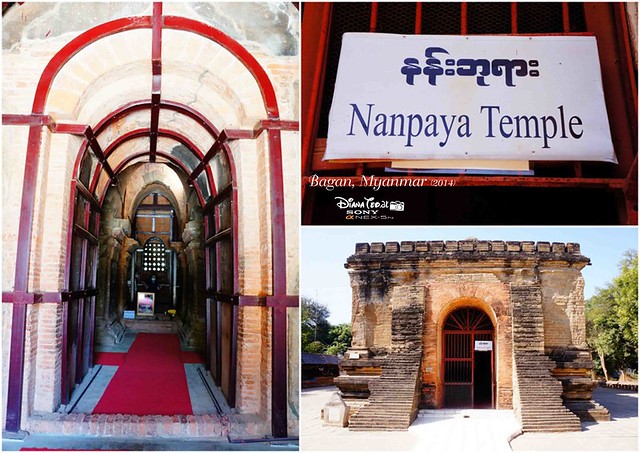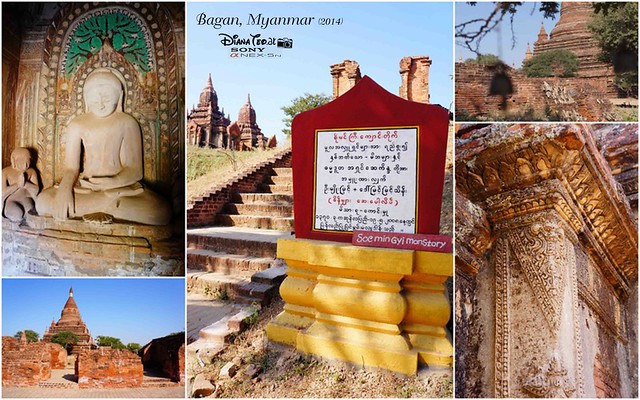Previous Post: Day 2 in Bagan - Temples & Pagodas Hopping (Part 1)
Not just one but we spent completely two days solely for temples and pagoda hopping around this home to the largest and densest concentration of more than 2,000 Buddhist temples, pagodas, stupas and monasteries. Instead of charter a whole van like we did yesterday, my friends and I decided to rent a horse cart with driver and few bikes as there were two in our group who didn't know how ride a bike.
Date Visited: 11th January 2014
So now let's me continue the second part of temples and pagoda we visited on the second day in Bagan:
Soemingyi Pagoda

Somewhere in the middle of New Bagan, Soemingyi Monastery is one of the few brick-built monasteries on the Bagan plain - most were built of wood and unfortunately didn't survive. This ruined complex consists of a main hall, surrounded by a lobby to the East, a chapel to the West and small cells to the North and South. The chapel is a small, square, 2 storey-building with a door opening on the east side, connecting it with the central hall by a passage.
Nanpaya Temple

According to the legend, Nanpaya Temple is said to have been used as prison although with limited of evidence. There is also another legend saying that this shrine was originally Hindu. Nanpaya is in fact Bagan's first cave shrine features interesting arches over the windows. It is made of sandstone masonry block facings integrated over a brick core and consists of perforated stone winows which are typical of earlier Bagan architecture.
Manuha Phaya

Situated not far away from Nanpaya Temple, Manuha Phaya was named upon the King who built this. King Manuha built himself this two-storey square white temple and through it conveyed a melancholy message. The three Buddha images are uncomfortably large for their enclosure, thus illustrating his captivity and mental stress. The facial expressions of the two seated images are grim.
Before we continue with the rest of sightseeing, we had Chinese cuisines for our lunch break as recommended by the horse chart driver.

MahaBodhi Temple

Just off the main road of Old Bagan, MahaBodhi Temple is a replica of the temple of the same name at Bodhagaya in India's Bihar state, the site where the Buddha achieved enlightment. The Bagan version is typical of India's Gupta Period and it's quite different from the other standard bell-shaped Burmese temples. With its notable pyramidal spire, it was the first ever temple in which a large number of seated Buddha figures were places in exterior niches.
Ananda Temple
One of the popular temple in Bagan, Ananda temple is considered to be one of the most surviving masterpiece of the Mon architecture. It is also know as the finest, holiest, largest, best preserved and most revered among all the Bagan temples. This is absolutely one of the temples shouldn't be missed by any visitors when one in this ancient city.

The largest and widest temple in Bagan, Dhammayangyi Temple is presumed to build by a wicked King who assassinated his own father and elder brother and in order to atone his sins, he decided to build this. Apart well-known for its intriguing history, this pyramidal temple is popular among the visitors for its incredibly fine brickwork. The temple's interior is bricked up for unknown reasons, thus only four porches and the outer corridors are accessible with each contains a seated Buddha image.
This is how we ended our tour in Bagan
How To Get Around Bagan
1) Rental of horse chart with a driver cost us 25,000 kyats for a full day (approx. to US$26 or RM85). It's not the ideal way to travel with as it is tends to be slower, shaky, bumpy and uncomfortable with. However, passengers are sheltered away from both sun and rain as Myanmar's weather can be scorching hot.
2) As for rented bikes, it cost us 2,500 kyats each (approx. to US$2.50 or RM8). Don't forget to wear mask as the roads were relatively dusty.

On the other note, here is the Myanmar version of DreamWorks logo
[Credit To: Myanmar Travel, Bagan: Ancient City of Myanmar]






Không có nhận xét nào:
Đăng nhận xét